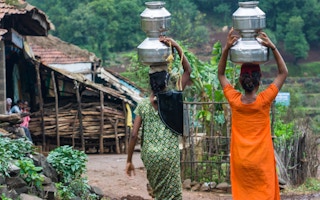The Asia Pacific region is failing to meet almost two-thirds of the targets set by the United Nations’ Sustainable Development Goals (SDGs), according to a recent report by the UN.
To continue reading, subscribe to Eco‑Business.
There's something for everyone. We offer a range of subscription plans.
- Access our stories and receive our Insights Weekly newsletter with the free EB Member plan.
- Unlock unlimited access to our content and archive with EB Circle.
- Publish your content with EB Premium.
The report found that the world’s most populous region has fallen behind on 37 out of 57 SDGs’ targets.
But how can anyone be surprised?
Asia Pacific has the largest population of people clawing their way out of poverty, while the developed world ruthlessly exploits them for our own well-being.
Following the developed world models of GDP growth means only part of the population reaps the benefits of development, leaving countries without the luxury of acting on SDG goals such as climate change, life below water, and life on land, as they try to grow wealth to meet the exploitative demands of the developed world.
“
Goal 17, Partnerships for the Goals, is an insidious goal. It undermines critics of the SDGs as non-team-players, but if we are to make the SDGs achieve their potential, we need to critically debate and improve the SDGs.
Whatever progress might seem to have been made in the short-term, our collective failure on climate change and biodiversity represent an existential threat, and the fault is the SDGs themselves.
There seem to be three major problems with the SDGs:
1. Failure to acknowledge the exploitation of the developing world by the developed world
Although it is comfortable to believe that the rising tide raises all ships, globalisation has shown to increase inequity and exploitation of the poor by the wealthy.
Reducing poverty, Goal 1 of the SDGs, requires economic growth and employment (Goal 8), creating a tension between meeting domestic needs and producing for export. Global market competition gives the developed nations access to the cheapest sources of exports, allowing them to exploit developing nations and prolong their poverty.
2. The goals are wide ranging, interconnected and riddled with contradictions
Production for export requires a density of workers for mass production that promotes urbanisation (Goal 11). This concentrates prosperity within cities and increases inequality between city and rural populations, contradicting the aims of Goal 10, reduced inequality.
Reduced poverty leads to greater consumption (Goal 12) - more cars, greater energy use (Goal 7), more land and water exploitation (Goal 6) competing with domestic food production exacerbating hunger for those left behind. This undermines Goals 2 and 3, which are zero hunger and good health & well-being, respectively.
Greater consumption and producing goods for export increases waste and pollution, and greatly exacerbates global climate impacts (Goal 13), setting the world back in its professed goals to protect biodiversity, manage the impacts of waste (Goals 14 & 15), and preventing health damage to the population (Goal 3) – think China.
More consumption strains infrastructure to move goods (Goal 9), provide affordable energy (Goal 7), clean water and sewage disposal (Goal 6), and to safely handle waste – think India.
The increasing pressure to survive and prosper economically causes conflicted priorities for the poor between time for work and education (Goal 4) or to grow their own food (Goal 2).
Gender equality (Goal 5) and peace, justice and strong institutions (Goal 16) are highly shaped by history and culture but will also be affected by development - women becoming more autonomous, but perhaps also more exploitation of women and children.
Goal 17, Partnerships for the Goals, is an insidious goal. It undermines critics of the SDGs as non-team-players, but if we are to make the SDGs achieve their potential, we need to critically debate and improve the SDGs.
“
Any corporation or government that claims achievements in any of the SDGs is trading in greenwash if they cannot first demonstrate rapid transition to renewable energy and emissions reductions commensurate with a 1.5 degrees Celsius climate stabilisation.
3. The goals are unprioritised
This is probably the most critical problem with the SDGs.
Economic and social development goals are listed ahead of environmental sustainability goals (Goals 13, 14 & 15), but if we continue to fail on climate action then we will certainly fail at all SDGs. Climate change may affect the poor first, but it poses an existential threat to all of mankind. The SDGs must not be complacent to these threats.
We already have year-on-year global temperature rises, more extreme weather events, accelerated melting of polar ice, sea level rises, ocean acidification, coral bleaching and death, drought and wildfires, crop failure and the collapse of fisheries (Goals 2 & 3) and the mass extinction of species (Goals 14 & 15).
As the “third pole” of Himalayan ice recedes, the river flows feeding the most populated areas on Earth may change dramatically. Conflict over water will almost certainly increase (Goals 6, 2 & 16).
As desertification advances and crops fail and as low lying regions become inundated, migration and conflict (Goal 16) will increase as the haves try to hold onto what they have (Goal 10), and the have nots must fight for their survival.
The ecological systems that provide our food are also collapsing. Our insatiable demand to turn wilderness into dollars (Goals 1 & 8), our reckless climate impacts (Goal 13), our intensive agriculture for growing populations and our soil degradation (Goal 15), exacerbated by our pollution and waste is overwhelming nature’s capacity to respond (climate change, ozone layer depletion, acidification, ocean plastics, and so on).
The UN Paris Climate Accord and Biodiversity Conventions should cause Goals 13, 14 and 15 to never be compromised to any other goal. Any corporation or government that claims achievements in any of the SDGs is trading in greenwash if they cannot first demonstrate rapid transition to renewable energy (Goal 7) and emissions reductions commensurate with a 1.5 degrees Celsius climate stabilisation.
If the SDGs are to fulfil their potential, sustainability must be prioritised over development, because to fail to live within the earth’s carrying capacity is not sustainable.
You can’t breathe, eat or drink money.
Nigel Howard is principal at sustainability consultancy Clarity Environment











